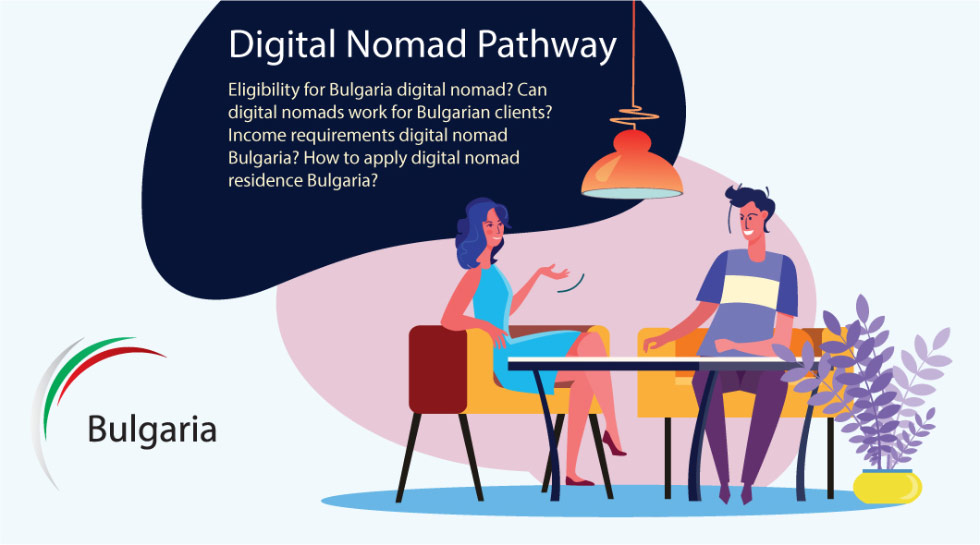Yes. Since the amendment to the Foreigners Act on June 18, 2025, has created a digital nomad pathway. Applicants enter with a Type D long-stay visa (valid up to 6 months with right of stay up to 180 days) and can then obtain prolonged residence (initially 1 year, typically extendable once). A key requirement is proving gross average annual income ≥ 50× Bulgaria’s minimum monthly wage for the previous calendar year.
Who qualifies as a “digital nomad” under the law?
The law targets non-EU foreigners who work remotely via IT for employers/clients outside Bulgaria/the EU. It covers three routes:
- Remote employees of a non-EU employer;
- Owners/partners/management (≥25% share) of a company registered outside the EU/EEA/CH, providing remote services from Bulgaria (no services to Bulgarian clients);
- Self-employed/freelancers who have provided remote services for at least 1 year before applying (again, not to Bulgarian clients).
Significant limitation: While on this status, you may not work for Bulgarian entities or provide services on the Bulgarian market.
Visa & residence timeline (what “6 months” really means)
- Type D visa: valid up to 6 months / stay up to 180 days—this is the entry visa to start the process.
- Residence permit: after entry, apply for prolonged residence (issued for 1 year) and may be extended once for another year (total up to 2 years).
Income threshold (how much you must show)
You must evidence gross average annual income of at least 50× the Bulgarian minimum monthly wage for the preceding year (documents can include employment contracts, bank statements, etc.). The estimated required yearly income for 2025 is approximately € 27,500.
Schengen alignment & short-stay counting
The amendments also align short-stay rules with the Schengen Area, as time spent in Bulgaria now counts towards the 90/180-day rule within the Schengen Area. Holders of a Bulgarian residence card can generally make short trips within Schengen (up to 90/180), consistent with Schengen practice.
Application steps (at a glance)
- Apply for Type D at a Bulgarian consulate with proof you fit one of the categories, income ≥ 50× minimum wage, health insurance, and standard documents.
- Enter Bulgaria on a D visa.
- Apply for residence at the Migration Directorate (1 year, extendable once).
Note on taxes & social insurance: No Bulgarian work permit is required under this track. Your tax and social security position depends on personal facts (tax residence, treaty coverage, employment vs. freelance). Bulgaria has a flat 10% income tax, but individual compliance should be confirmed with a tax advisor.
You can make your first step into understanding Bulgarian income tax for foreigners here.
More Information:
- Bulgarian Telegraph Agency (BTA) News – June 18, 2025: Parliament Amends Foreigners Act to Introduce Digital Nomad Residence – Official news confirming the addition of “digital nomads” as eligible for residence permits, with definition and initial visa rules – Web: BTA.
You Will Also Like To Know About:
- Do third-country nationals (non-EU citizens) need a visa to live in Bulgaria long-term?
- Do UK nationals need a visa to live in Bulgaria after Brexit?
- Can EU/EEA and Swiss citizens live in Bulgaria without a visa?
Legal Disclaimer: The information in this article (part of the Stay in Bulgaria FAQ series—EU/EEA/Swiss citizens, UK nationals, third-country nationals, citizens of developing countries, digital nomads, and family members of Bulgarian citizens) is for general informational purposes only and does not constitute legal advice. It does not create an attorney-client relationship. Laws and procedures (including Schengen/90-day rules, Type D visas, residence permits, and related EU/Bulgarian regulations) are subject to frequent changes; therefore, content may be incomplete or out of date. External links are provided for convenience; we are not responsible for their content. For advice tailored to your situation, consult the Migration Directorate (Ministry of Interior), the Ministry of Foreign Affairs, or a licensed immigration attorney. Last updated: September 2025.



